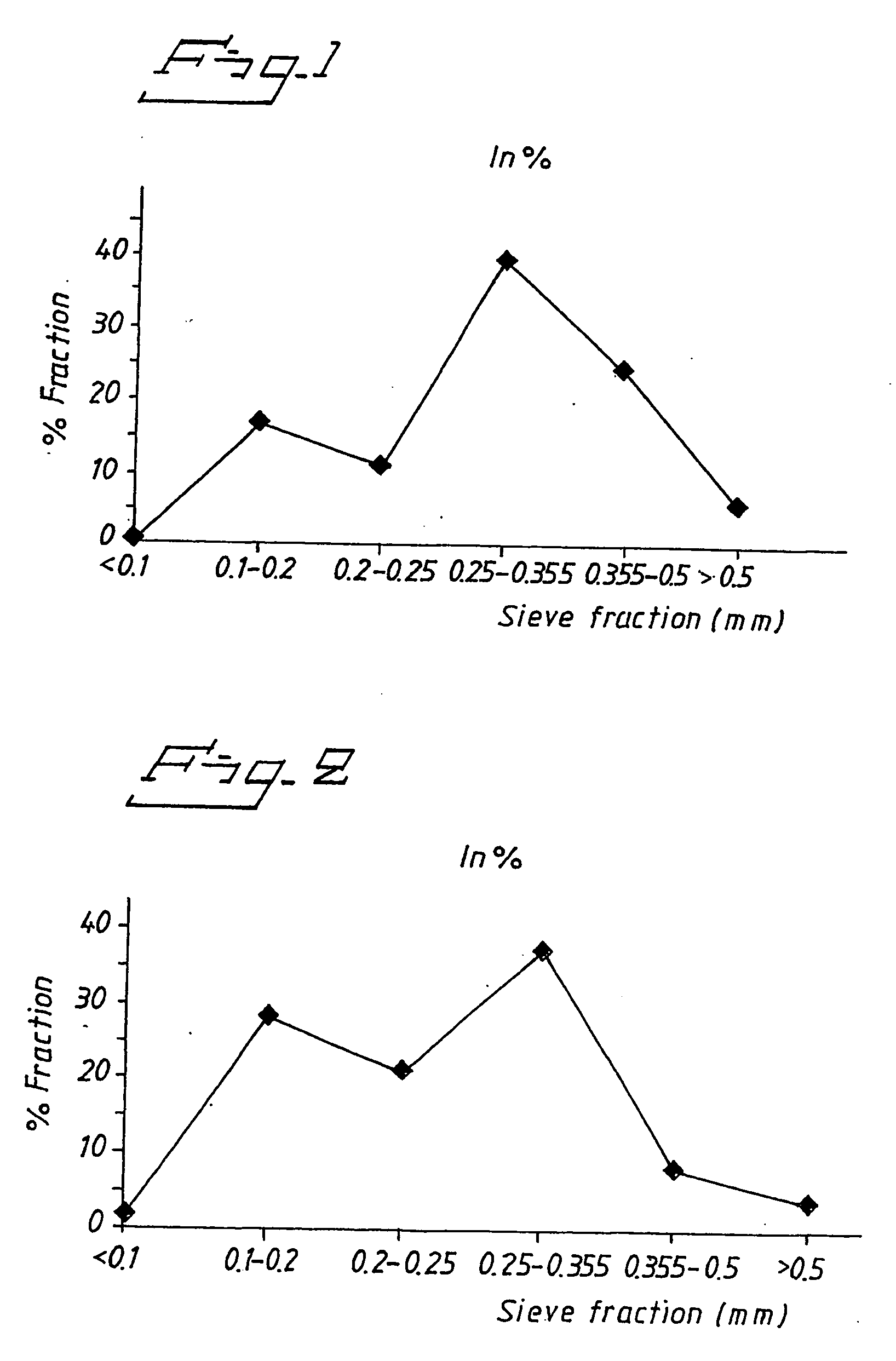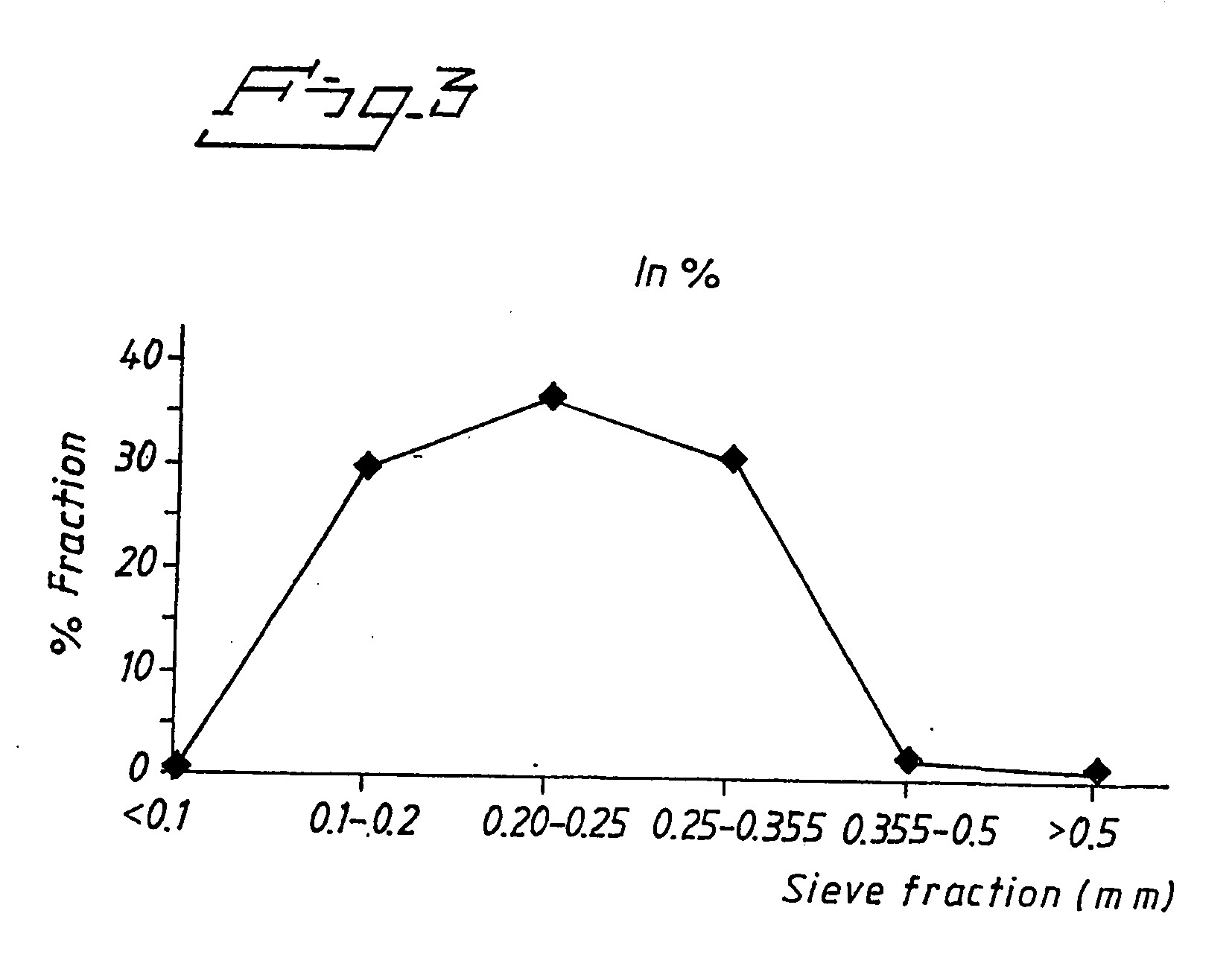Method to obtain microparticles containing an H+,K+-ATP-ASE inhibitor
a technology of atpase inhibitors and microparticles, which is applied in the direction of microcapsules, heterocyclic compound active ingredients, biocide, etc., can solve the problems of difficult to achieve acceptable microparticles, many drugs are sensitive to heat and will deteriorate, and all existing techniques suffer from one or more drawbacks, etc., to achieve sufficient mechanical strength and low friability
- Summary
- Abstract
- Description
- Claims
- Application Information
AI Technical Summary
Benefits of technology
Problems solved by technology
Method used
Image
Examples
example 1
Omeprazole Magnesium with Hydroxypropylmethylcellulose (HPMC) and Polysorbate 80
[0078] A suspension containing omeprazole magnesium was made according to the composition below:
Omeprazole magnesium200gHPMC (6 cps)35.4gPolysorbate 804.00gWater360g
[0079] Weight percent of dry content in suspension: 39.9 weight % (32.3 vol %).
[0080] First, polysorbate 80 was mixed with the water. The HPMC (6 cps) was then added and dissolved during stirring with subsequent addition of omeprazole magnesium (prepared as in EP 97921045.7). The suspension was then deagglomerated by high-shear mixing. The deagglomerated suspension was fed through a pneumatic nozzle with a diameter of 1.0 mm at a speed of about 18 g / min. The pressure of the atomizer was 1 bar. The spray formed first hit the cold gas above a vessel filled with liquid nitrogen that was stirred to get a better wetting and instantaneous freezing of the droplets. The frozen droplets have a higher density that liquid nitrogen which make them si...
example 2
Esomeprazole Magnesium with HPMC
[0084] A suspension containing esomeprazole magnesium was made according to the composition below:
Esomeprazole magnesium200gHPMC (6 cps)35.3gWater383.9g
[0085] Weight percent of dry content in suspension: 38 weight % (31.5 vol %).
[0086] First, HPMC (6 cps) was added and dissolved in water during stirring with subsequent addition of esomeprazole magnesium (prepared as in EP 95926068.8). The suspension was then deagglomerated by high-shear mixing. The deagglomerated suspension was fed through a rotary nozzle with a diameter of 50 mm at a rotation speed of 5200 rpm and pumping rate of about 18 g / min. The spray formed first hit the cold gas above a vessel filled with liquid nitrogen that was stirred to get a better wetting and instantaneous freezing of the droplets. The frozen droplets have a higher density that liquid nitrogen which make them sink to the bottom of the vessel. The frozen droplets / microparticles were then placed in a conventional freeze...
example 3
Esomeprazole Magnesium with Polyvinyl Alcohol (PVOH), Polyethylene Glycol (PEG) 400 and Polysorbate 80
[0094] A suspension containing esomeprazole magnesium was made according to the composition below:
Esomeprazole magnesium200gPolyvinyl alcohol (10.2% solution in water)276.8gPolyethylene glycol 4007.05gPolysorbate 804gWater142g
[0095] Weight percent of dry content in suspension: 38% (31.5 vol %).
[0096] First, polysorbate 80 was dissolved in water. Then PEG 400 was added and dissolved in water during stirring. Polyvinyl alcohol solution was added with subsequent addition of esomeprazole magnesium. The suspension was then deagglomerated by high-shear mixing. The deagglomerated suspension was fed through a rotary nozzle with a diameter of 50 mm at a rotation speed of 5200 rpm and pumping rate of about 18 g / min. The spray formed first hit the cold gas above a vessel filled with liquid nitrogen that was stirred to get a better wetting and instantaneous freezing of the droplets. The fro...
PUM
| Property | Measurement | Unit |
|---|---|---|
| size | aaaaa | aaaaa |
| size | aaaaa | aaaaa |
| porosity | aaaaa | aaaaa |
Abstract
Description
Claims
Application Information
 Login to view more
Login to view more - R&D Engineer
- R&D Manager
- IP Professional
- Industry Leading Data Capabilities
- Powerful AI technology
- Patent DNA Extraction
Browse by: Latest US Patents, China's latest patents, Technical Efficacy Thesaurus, Application Domain, Technology Topic.
© 2024 PatSnap. All rights reserved.Legal|Privacy policy|Modern Slavery Act Transparency Statement|Sitemap



